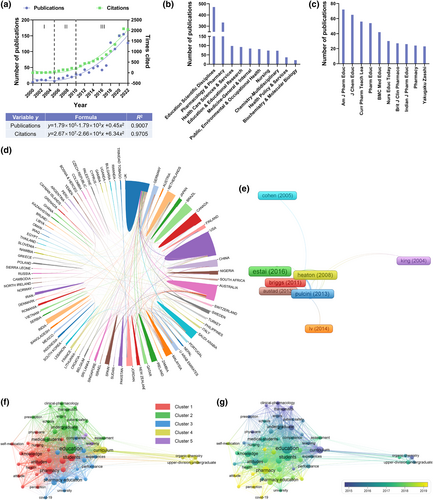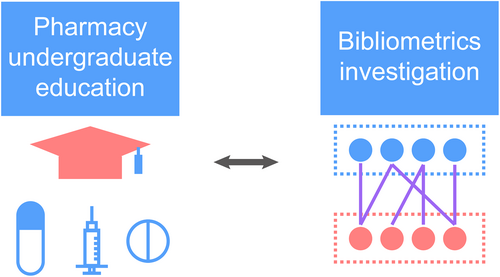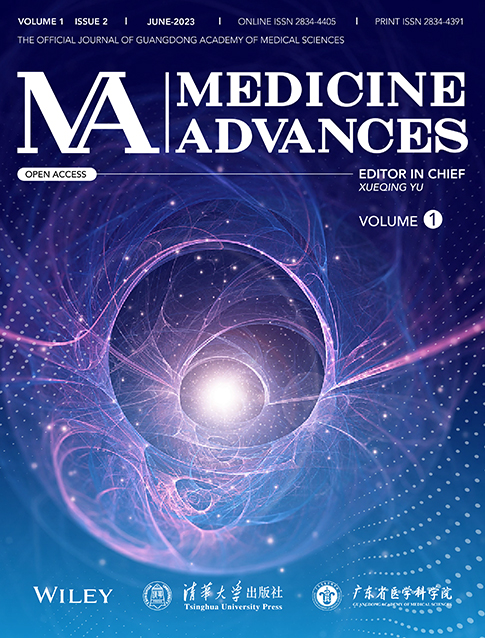Bibliometric investigation of undergraduate pharmacy education since the millennium via web of science
Graphical Abstract
Abbreviations
-
- COVID-19
-
- Coronavirus Disease 2019
-
- TDM
-
- therapeutic drug monitoring
-
- TS
-
- topic theme
Dear Prof. Xueqing Yu,
The human demand for and pursuit of a healthy life has been greatly emphasized since the turn of the millennium, which has likewise increased the demand for medical personnel. In particular, medical personnel became a critical resource globally during the COVID-19 pandemic [1]. As one of the most indispensable medical personnel, pharmacists who are capable and responsible for pharmacy services, including prescription verification, formulation preparation, therapeutic drug monitoring (TDM), and pharmacy counseling, are playing increasingly important roles in medical practices [2]. A prerequisite for improving the quality of pharmacy services is to establish high-quality pharmacy education. Fundamental research on pharmacy education should be conducted to ensure that pharmacy services evolve continuously in response to emerging clinical scenarios. Summarizing the current studies on pharmacy education will help facilitate innovative decision-making in this field [3]. In this context, a bibliometric investigation is needed to showcase the status quo of the current knowledge in pharmacy education.
We previously reported a bibliometric investigation of postgraduate pharmacy education [4]; therefore, we would like to conduct a complementary survey on undergraduate pharmacy education. We consulted the Web of Science's Core Collection database on February 16, 2023 for this bibliometric analysis. The inquiry set is shown in Table 1, where we limited the publication type to “article” and “review” using 2000–2022 as the focal timespan. The retrieved 1,136 publications were analyzed by Clarivate Analytics, Bibliometric.com (https://bibliometric.com/), and VOSviewer (version 1.6.18, Leiden University, Leiden, The Netherlands) [5], and the results are shown in Figure 1 and the Supplementary Information.
| Step | Formula | Notea |
|---|---|---|
| #1 | TS = pharmacb | TS set as pharmacyb |
| #2 | TS = undergraduatb | TS set as undergraduatb |
| #3 | TS = educatb | TS set as educatb |
| #4 | #1 AND #2 AND #3 | (TS = pharmacb) AND (TS = undergraduatb) AND (TS = educatb) |
- a TS, topic theme.
- b Autofill.

Summary of bibliometric results (n = 1,136). (a) Temporal growth of publications and citations (upper panel). I–III refer to the latency and initial and exponential periods, respectively, for the fitted formulas of scattered plots (lower panel). (b) Top 10 research categories and (c) Top 10 publishing journals. (d) Transregional cooperation profile. (e) Bibliographic coupling clustered network (eligible threshold: 40). (f) Keywords co-occurrence clustered network (eligible threshold: 20). (g) Keywords co-occurrence time-overlay network (eligible threshold: 20).
Following the stage-wise growth of concepts in bibliometric studies [6], we found that the number of publications and citations presented a three-stage growth in 2000–2022 and has now entered a period of exponential growth (Figure 1a), which demonstrates that pharmacy studies is a fast-evolving field. Using the fitted formulas, we estimated that there would be approximately 2,000 papers and 2,500 citations published in 2023. The top 10 research categories (Figure 1b) and publishing journals (Figure 1c) were mainly associated with education and pharmacological sciences. The USA, UK, Australia, Canada and Brazil were the most productive regions (Figure 1d) and the transregional cooperation tiles were well established. Interestingly, collaboration was far less active at the institute and investigator level, even for top contributors (Tables S1–2; Figures S1–2), which may mean that a considerable number of non-top contributing institutes and investigators participate in transregional cooperation. Other peripheral bibliometric data are summarized in Tables S3–7, including the top organizations, authors, publishers, and funding agencies, indexed databases, languages, publication types, keyword clouds, and term co-occurrence visualization, among other data.
Bibliographic coupling was employed to describe the prevailing research paradigms in this field. The representative publications for each paradigm are shown in Figure 1e, listed in Table S8 and following. Cohen (2005): Complementary therapies in clinical practices; King (2004): Needs in pharmacological education; Estai (2016): Teaching practice in education; Heaton (2008): Preparedness for prescribing; Briggsl (2011): Integration and interprofessional education; Austad (2013): Connection with pharmaceutical industry; Pulcini (2013): Antibiotic prescribing education; Lv (2014): Antibiotic self-medication of students. We could integrate these paradigms into two aspects: (1) Professional and interprofessional training and (2) Clinical and self-medication practice, especially antibiotic administration.
Keyword analysis was subsequently performed to mine these research hotspots. An intriguing word cloud figure of keywords was obtained (see Figure S3). Networks connecting high-frequency keywords were generated by VOSviewer. The clustered network displayed five clusters that conveyed the following concepts (Figure 1f): Cluster 1, Perception and attitude toward clinical practices; Cluster 2, Prescription training and assessment; Cluster 3, Teaching performance and experience in the COVID-19 era; Cluster 4, Curriculum arrangement and optimization; Cluster 5, Teaching performance and experience. The research foci mirrored by the clusters were basically in parallel with the bibliographic coupling results. Most keywords in Clusters 2, 4, and 5 had a mean publication time in 2015–2016, while some in Clusters 1 and 3 were published in 2017–2018; however, these keywords reflected previous research foci (Figure 1g). The mean publication time for some keywords, such as COVID, attitudes, or perceptions, was noticeably before 2019, which suggested that the current hotspot was the students' perceptions and attitudes toward clinical practices during the COVID-19 pandemic period. Terms analysis was launched to supplement the keyword analysis (see Figures S4–5 for the results). As indicated by the time-overlay network, the impact of the COVID-19 pandemic on pharmacy education again stood out as an emerging topic. Apart from this emphasis on the impact of COVID-19, antibiotic prescription education was another burgeoning field, which might be due to the increase in antibiotic use during the pandemic [7]. In summary, the research hotspots in this field were (1) students' perceptions and attitudes toward clinical practices and (2) antibiotic prescription training during the COVID-19 pandemic.
- (a)
Professional and interprofessional training will always be a critical topic in undergraduate pharmacy education, although not these areas do not necessarily present as research hotspots. Regardless of the rapid development of teaching methods, assessment systems, and residency regulation, the core aim of undergraduate education is to improve the students' professional skills [8]. Investigators in this field are encouraged to make continuous efforts to update their (inter)professional training system. By taking advantage of active transregional collaborations (Figure 1d), practitioners can seek to establish a robust international training structure.
- (b)
Considering that the influence of the COVID-19 pandemic on undergraduate pharmacy education is a current research focus, future research hotspots could shift to the impact of another unpredicted worldwide pandemic. We argue that it is advisable for investigators to perform early-warning studies to enhance our preparedness for future pandemic outbreaks [9], such as influenza A and monkey pox [10] to name a few. For instance, constructing a fast-responding teaching and learning model under emergency and pandemic situations is significant.
In this work, we scrutinized the basic bibliometric properties, main research domains, and current research hotspots of undergraduate pharmacy education and proposed some suggestions for future directions. In due course, we will write a comprehensive systematic review based on the retrieved information to offer additional underlying insights on these topics. In addition, we plan to use similar methodologies to reveal the status quo of pharmacy vocational and continuous educational practices.
Yours sincerely,
Zhengwei Huang, Rui Luo, Si Xiong, Chuanbin Wu, and Xin Pan
AUTHOR CONTRIBUTION
Zhengwei Huang: writing − original draft (lead); conceptualization (equal); visualization (lead). Rui Luo: data curation (lead); investigation (supporting). Si Xiong: visualization (equal); data curation (supporting). Chuanbin Wu: project administration (lead); writing − review & editing (supporting). Xin Pan: writing − review & editing (lead); project administration (equal); data curation (supporting).
ACKNOWLEDGMENTS
We are grateful for the support from the National Natural Science Foundation of China (grant No. 82104070) and Guangdong Universities Keynote Regions Special Funded Project (grant No. 2022ZDZX2002).
CONFLICT OF INTEREST STATEMENT
The authors declare no conflicts of interest.
FUNDING INFORMATION
Guangdong Universities Keynote Regions Special Funded Project, Grant/Award Number: 2022ZDZX2002; National Natural Science Foundation of China, Grant/Award Number: 82104070
ETHICS STATEMENT
Not applicable.
INFORMED CONSENT
Not applicable.
Open Research
DATA AVAILABILITY STATEMENT
The data that support the findings of this study are available on request from the corresponding author.





